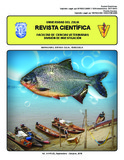Edad y crecimiento del morocoto Piaractus brachypomus en la región del Orinoco medio en Venezuela

View/
Date
2019Palabras Clave
Peces de agua dulce, Biología pesquera, Recursos pesqueros, Characidae, Río OrinocoFreshwater fish, Fishing biology, Fishing resources, Characidae, Orinoco river
Metadata
Show full item recordAbstract
Se determinó la edad de Piaractus brachypomus descomponiendo la distribución de frecuencias de talla en cohortes que representaron edades, utilizando el método de Battacharya; mientras que el estudio del crecimiento se hizo por la inferencia de múltiples modelos, usando el criterio de la información de Akaike (AIC) para seleccionar el de mejor ajuste. Los modelos propuestos fueron las versiones unificadas del modelo de Richards (U-Richards), von Bertalanffy (U-von Bertalanffy), Logístico (U-Logístico) y Gompertz (U-Gompertz). La edad estuvo comprendida entre uno y tres años (a) de edad, con los peces de un a midiendo 13,0±1,9 centímetro (cm) de longitud total, los de dos a 25,2±3,0 cm de LT, y los de tres a 36,3±2,8 cm de LT. Desde el punto de vista estadístico, forma
de la curva, AIC y biológico, el modelo de mejor ajuste fue el U-Gompertz, el cual produjo una curva sigmoidea determinada por una longitud asintótica de L ∞ = 71,9 cm de LT, una tasa de crecimiento relativo K = 0,148 a -1 , un punto de inflexión en la curva T i = 2,02 a y un punto inicial de la curva W o = 8 cm de LT. P. brachypomus presentó un crecimiento relativamente lento que la hace vulnerable a la explotación pesquera, y por lo tanto, debe ser adecuadamente administrada.
Collections
Información Adicional
| Otros Títulos | Age And Growth Of Morocoto Piaractus Brachypomus In The Venezuela Orinoco Medium Region |
| Correo Electrónico | 1angelgonzalez78@hotmail.com |
| Editor | SaberULA |
| ISSN | 0798-2259 |
| ISSN Electrónico | 2477-944X |
| Resumen en otro Idioma | The age of Piaractus brachypomus was determined by decomposing the distribution of length frequencies in cohorts that represented ages, using the Battacharya method; while the growth study was done by inference of multiple models, using the Akaike information criterion (AIC) to select the best fit. The models proposed were the unified versions of the model of Richards (U-Richards), von Bertalanffy (U-von Bertalanffy), Logistic (U-Logistic) and Gompertz (U-Gompertz). The age was between one and three year of age (y), with fish from one y measuring 13.0 ± 1.9 centimeter (cm) of (TL), those from two y 25.2 ± 3.0 cm of total length, and those from three 36.3 ± 2.8 cm of total length. From the statistical point of view, shape of the curve, AIC and biological, the best fit model was the U-Gompertz, which produced a sigmoidal curve determined by an asymptotic length of L ∞ = 71.9 cm of TL, a relative growth rate K = 0.148 y -1 , a point of inflection in the curve T i = 2.02 y and an initial point of the curve W o = 8 cm of TL. P. brachypomus presented a relatively slow growth that makes it vulnerable to fishing exploitation, and therefore, must be properly managed. |
| Colación | 386-392 |
| País | Venezuela |
| Institución | Universidad del Zulia (LUZ) Universidad de Los Andes (ULA) |
| Publicación Electrónica | Revista Científica |





